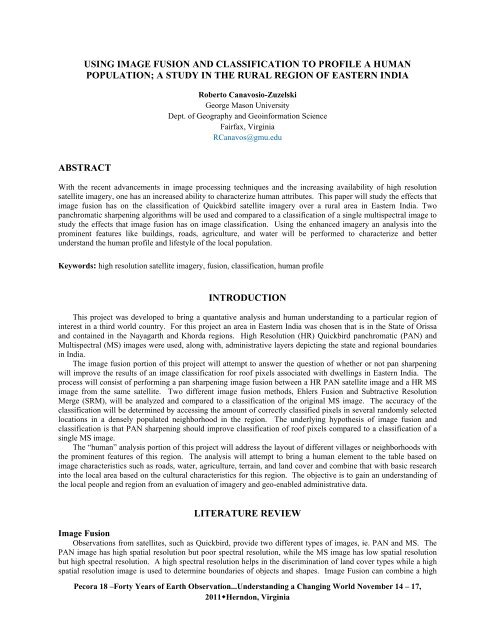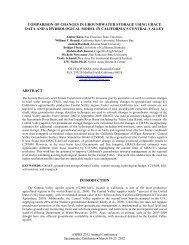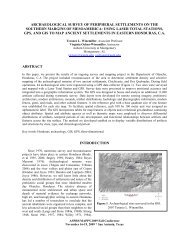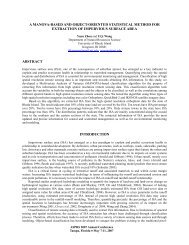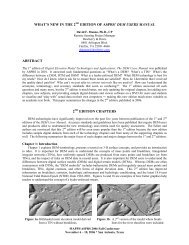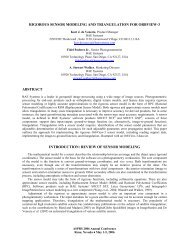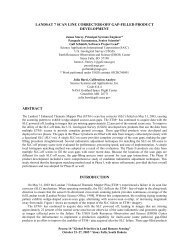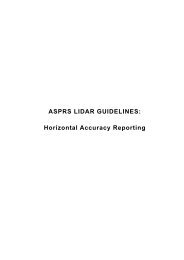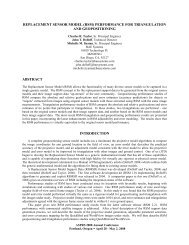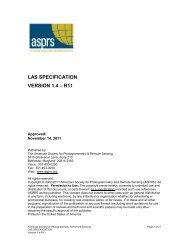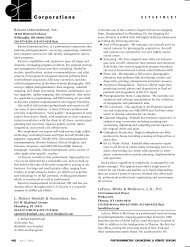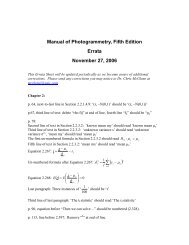using image fusion and classification to profile a human ... - asprs
using image fusion and classification to profile a human ... - asprs
using image fusion and classification to profile a human ... - asprs
You also want an ePaper? Increase the reach of your titles
YUMPU automatically turns print PDFs into web optimized ePapers that Google loves.
USING IMAGE FUSION AND CLASSIFICATION TO PROFILE A HUMAN<br />
POPULATION; A STUDY IN THE RURAL REGION OF EASTERN INDIA<br />
ABSTRACT<br />
Rober<strong>to</strong> Canavosio-Zuzelski<br />
George Mason University<br />
Dept. of Geography <strong>and</strong> Geoinformation Science<br />
Fairfax, Virginia<br />
RCanavos@gmu.edu<br />
With the recent advancements in <strong>image</strong> processing techniques <strong>and</strong> the increasing availability of high resolution<br />
satellite <strong>image</strong>ry, one has an increased ability <strong>to</strong> characterize <strong>human</strong> attributes. This paper will study the effects that<br />
<strong>image</strong> <strong>fusion</strong> has on the <strong>classification</strong> of Quickbird satellite <strong>image</strong>ry over a rural area in Eastern India. Two<br />
panchromatic sharpening algorithms will be used <strong>and</strong> compared <strong>to</strong> a <strong>classification</strong> of a single multispectral <strong>image</strong> <strong>to</strong><br />
study the effects that <strong>image</strong> <strong>fusion</strong> has on <strong>image</strong> <strong>classification</strong>. Using the enhanced <strong>image</strong>ry an analysis in<strong>to</strong> the<br />
prominent features like buildings, roads, agriculture, <strong>and</strong> water will be performed <strong>to</strong> characterize <strong>and</strong> better<br />
underst<strong>and</strong> the <strong>human</strong> <strong>profile</strong> <strong>and</strong> lifestyle of the local population.<br />
Keywords: high resolution satellite <strong>image</strong>ry, <strong>fusion</strong>, <strong>classification</strong>, <strong>human</strong> <strong>profile</strong><br />
INTRODUCTION<br />
This project was developed <strong>to</strong> bring a quantative analysis <strong>and</strong> <strong>human</strong> underst<strong>and</strong>ing <strong>to</strong> a particular region of<br />
interest in a third world country. For this project an area in Eastern India was chosen that is in the State of Orissa<br />
<strong>and</strong> contained in the Nayagarth <strong>and</strong> Khorda regions. High Resolution (HR) Quickbird panchromatic (PAN) <strong>and</strong><br />
Multispectral (MS) <strong>image</strong>s were used, along with, administrative layers depicting the state <strong>and</strong> regional boundaries<br />
in India.<br />
The <strong>image</strong> <strong>fusion</strong> portion of this project will attempt <strong>to</strong> answer the question of whether or not pan sharpening<br />
will improve the results of an <strong>image</strong> <strong>classification</strong> for roof pixels associated with dwellings in Eastern India. The<br />
process will consist of performing a pan sharpening <strong>image</strong> <strong>fusion</strong> between a HR PAN satellite <strong>image</strong> <strong>and</strong> a HR MS<br />
<strong>image</strong> from the same satellite. Two different <strong>image</strong> <strong>fusion</strong> methods, Ehlers Fusion <strong>and</strong> Subtractive Resolution<br />
Merge (SRM), will be analyzed <strong>and</strong> compared <strong>to</strong> a <strong>classification</strong> of the original MS <strong>image</strong>. The accuracy of the<br />
<strong>classification</strong> will be determined by accessing the amount of correctly classified pixels in several r<strong>and</strong>omly selected<br />
locations in a densely populated neighborhood in the region. The underlying hypothesis of <strong>image</strong> <strong>fusion</strong> <strong>and</strong><br />
<strong>classification</strong> is that PAN sharpening should improve <strong>classification</strong> of roof pixels compared <strong>to</strong> a <strong>classification</strong> of a<br />
single MS <strong>image</strong>.<br />
The “<strong>human</strong>” analysis portion of this project will address the layout of different villages or neighborhoods with<br />
the prominent features of this region. The analysis will attempt <strong>to</strong> bring a <strong>human</strong> element <strong>to</strong> the table based on<br />
<strong>image</strong> characteristics such as roads, water, agriculture, terrain, <strong>and</strong> l<strong>and</strong> cover <strong>and</strong> combine that with basic research<br />
in<strong>to</strong> the local area based on the cultural characteristics for this region. The objective is <strong>to</strong> gain an underst<strong>and</strong>ing of<br />
the local people <strong>and</strong> region from an evaluation of <strong>image</strong>ry <strong>and</strong> geo-enabled administrative data.<br />
LITERATURE REVIEW<br />
Image Fusion<br />
Observations from satellites, such as Quickbird, provide two different types of <strong>image</strong>s, ie. PAN <strong>and</strong> MS. The<br />
PAN <strong>image</strong> has high spatial resolution but poor spectral resolution, while the MS <strong>image</strong> has low spatial resolution<br />
but high spectral resolution. A high spectral resolution helps in the discrimination of l<strong>and</strong> cover types while a high<br />
spatial resolution <strong>image</strong> is used <strong>to</strong> determine boundaries of objects <strong>and</strong> shapes. Image Fusion can combine a high<br />
Pecora 18 –Forty Years of Earth Observation...Underst<strong>and</strong>ing a Changing World November 14 – 17,<br />
2011Herndon, Virginia
spatial resolution PAN <strong>image</strong> with a low spatial resolution MS <strong>image</strong> <strong>to</strong> create a new MS <strong>image</strong> with high spatial<br />
resolution (Li <strong>and</strong> Li, 2010). While a lot of research has been done on developing algorithms for different <strong>fusion</strong><br />
techniques not much work has been done on the effect of <strong>fusion</strong> on successive applications like <strong>image</strong> <strong>classification</strong><br />
(Li <strong>and</strong> Li, 2010). Several different types of <strong>image</strong> <strong>fusion</strong> techniques exist for combining a PAN <strong>and</strong> MS <strong>image</strong>,<br />
including Brovey Transform (BT), Modified Intensity-Hue-Saturation (M-HIS), Principal Component Analysis<br />
(PCA), High Pass Filter (HPF), Smoothing Filter-based Intensity Modulation (SFIM), Wavelet transform, Ehlers<br />
Fusion, (Li <strong>and</strong> Li, 2010) <strong>and</strong> Subtractive Resolution Merge (SRM) ( Zheng Rong-er , Jie, Yi, <strong>and</strong> Tingwei, 2008).<br />
The SRM <strong>fusion</strong> method was chosen for this project because it is based on a fairly new concept of combining<br />
<strong>image</strong> segmentation with a RGB color analysis <strong>to</strong> group pixels in<strong>to</strong> like categories. The color model is based on<br />
mixing colors of cyan, magenta, yellow, <strong>and</strong> black <strong>to</strong> form other colors. Additional colors are added <strong>to</strong> the scene<br />
based on the “brightness” of MS value for that color. The resulting fused <strong>image</strong> is more color diverse based on<br />
measurements in the MS <strong>image</strong> (Zhang, Wang, Chen, Zhang, 2005).<br />
The Ehlers Fusion method was developed <strong>to</strong> specifically address preserving spectral <strong>image</strong> characteristics when<br />
combining with a HR PAN <strong>image</strong>. The principle idea being the HR <strong>image</strong> has <strong>to</strong> sharpen the MS <strong>image</strong> without<br />
adding new gray level information <strong>to</strong> its spectral components. The Ehlers method should enhance high frequency<br />
changes such as edges <strong>and</strong> high frequency gray level changes in an <strong>image</strong> without altering the MS components in<br />
homogeneous regions (Ehlers, 2004). To do this Ehlers method combines a st<strong>and</strong>ard IHS transform with fast<br />
Fourier transform filtering of both the PAN <strong>image</strong> <strong>and</strong> the intensity component of the MS <strong>image</strong> (Li <strong>and</strong> Li, 2010).<br />
The Ehlers method was chosen for this project because it combines the best parts of several existing algorithms <strong>to</strong><br />
address the shortfalls of each of those methods.<br />
Other approaches <strong>to</strong> <strong>classification</strong> <strong>and</strong> feature extraction of remote sensing <strong>image</strong>s involve <strong>classification</strong> of HR<br />
PAN <strong>image</strong>s in urban areas <strong>using</strong> morphological <strong>and</strong> neural approaches. This work combines <strong>image</strong> segmentation<br />
with edge detection <strong>and</strong> region growing <strong>to</strong> make use of how features are oriented amongst each other instead of<br />
strictly <strong>using</strong> feature boundaries (Benediktsson, Pesaresi, <strong>and</strong> Arnason, 2003). A very recent study conducted by the<br />
University of Mississippi suggests that information extraction from HR <strong>image</strong>ry is sometimes hampered by the<br />
limited number of spectral channels available from the systems <strong>and</strong> that st<strong>and</strong>ard supervised <strong>classification</strong><br />
algorithms found in commercial software packages may misclassify different features with similar spectral<br />
characteristics; leading <strong>to</strong> a high occurrence of false positives (Momm, Gunter, <strong>and</strong> Easson, 2010). To counteract<br />
this authors use object geometry <strong>to</strong> group like pixels in subsequent <strong>image</strong>s, before <strong>and</strong> after hurricane Katrina. The<br />
draw back with this approach is that it relies on two datasets with one complementing the other, <strong>and</strong> in a general<br />
sense these datasets may not always be available for every area of interest.<br />
Settlement Morphology<br />
The concept of settlement morphology was chosen <strong>to</strong> bring a “Human” aspect <strong>to</strong> the project. The idea is <strong>to</strong> look<br />
at some basic layouts of different neighborhoods in this region <strong>and</strong> characterize the main physical attributes that go<br />
in<strong>to</strong> how the neighborhoods are laid out. For example, where the roads are in relation <strong>to</strong> where the houses are, is<br />
there a reason that the neighborhoods are located where they are, <strong>and</strong> what does the local l<strong>and</strong> cover say about how<br />
the neighborhoods were formed. To this end the following studies were reviewed related <strong>to</strong> this <strong>to</strong>pic.<br />
A current flagship study on this <strong>to</strong>pic entitled “Introduction <strong>to</strong> the Issue on Remote Sensing of Human<br />
Settlements: Status <strong>and</strong> Challenges” were the authors suggest a quantitative evaluation of the physical properties of<br />
a given area, including l<strong>and</strong> covers, material status, <strong>and</strong> l<strong>and</strong> usage (Gamba, Tupin, <strong>and</strong> Weng, 2008) was reviewed.<br />
The report displays some innovative researches going on in this field <strong>and</strong> provides an overview of the state-of-theart,<br />
along with, describing some of the challenges going forward. A key conclusion of the study was that more work<br />
on classifying HR <strong>image</strong>ry is needed due <strong>to</strong> the high spatial <strong>and</strong> spectral resolutions. Along these same lines, a<br />
paper discussing global trends in the remote sensing of <strong>human</strong> settlements (Forster, 2010) was reviewed. The study<br />
presents a brief his<strong>to</strong>ry of the <strong>to</strong>pic, examines the properties of current remote sensing systems <strong>and</strong> their acquired<br />
data, <strong>and</strong> presents some processing methods <strong>and</strong> urban applications.<br />
An integrative assessment of informal settlements <strong>using</strong> HR remote sensing data was conducted in the Delhi<br />
area of India (Niebergall, Loew, <strong>and</strong> Mauser, 2008). The study investigates the potential <strong>to</strong> use HR remote sensing<br />
data <strong>to</strong> identify urban structures <strong>and</strong> dynamic within the Delhi region. The paper presents a semi-au<strong>to</strong>mated, object<br />
oriented <strong>classification</strong> approach which allows for the identification of informal settlements within urban areas. The<br />
goal of the study is <strong>to</strong> provide indica<strong>to</strong>rs <strong>to</strong> identify socio-economic structures <strong>and</strong> their dynamics. Information on<br />
population <strong>and</strong> water related parameters are derived.<br />
A study in Central Canada used SPOT XS <strong>image</strong>ry <strong>to</strong> map exurbanite residential developments on the<br />
assumption that individual sites, under current development, possess a unique spectral signature (Brunger <strong>and</strong><br />
Treitx, 1987). The satellite <strong>image</strong>ry was cross referenced with <strong>to</strong>pographic maps <strong>and</strong> aerial pho<strong>to</strong>s <strong>and</strong> found <strong>to</strong><br />
Pecora 18 –Forty Years of Earth Observation...Underst<strong>and</strong>ing a Changing World November 14 – 17,<br />
2011Herndon, Virginia
educe <strong>classification</strong> error. Extraction of urban settlements <strong>using</strong> an au<strong>to</strong>matic approach on HR IKONOS <strong>image</strong>ry<br />
was performed (Tarantino et. al, 2003). The authors performed a maximum likelihood pixel <strong>classification</strong> on PAN<br />
sharpened <strong>image</strong>ry (1-meter resolution) <strong>to</strong> analyze changes in urban areas. Another study looked at population<br />
distribution characteristics <strong>and</strong> patterns based on remote sensing <strong>and</strong> GIS in a mountainous region in China (Shuwen<br />
et. al, 2006). A key conclusion is that population distribution is disperse <strong>and</strong> diverse in this region <strong>and</strong> that<br />
agriculture production is dominant.<br />
METHODOLOGY<br />
The <strong>image</strong> <strong>fusion</strong> portion of this project was developed <strong>to</strong> study the effects that pan sharpening <strong>image</strong> <strong>fusion</strong><br />
has on the <strong>classification</strong> of roof pixels for structures in a densely populated neighborhood in the Nayagarth Region<br />
of Eastern India. The processes consisted of cropping a local area of interest from the larger dataset, <strong>and</strong> performing<br />
a pan sharpening between a PAN <strong>image</strong> <strong>and</strong> a MS <strong>image</strong> from the Quickbird satellite. Two different <strong>fusion</strong><br />
algorithms were used, the Ehlers Fusion algorithm <strong>and</strong> the SRM algorithm. Once the pan sharpening was completed<br />
a two different <strong>classification</strong>s were performed, sub-pixel identification <strong>and</strong> a fully supervised maximum likelihood<br />
<strong>classification</strong> was performed on each <strong>image</strong>, along with a <strong>classification</strong> of the original MS <strong>image</strong>. The sub-pixel<br />
identification approach just classified the pixels that were the same in a single training category (roof), whereas, the<br />
fully supervised <strong>classification</strong> classified 10 categories of pixels based on training classes for vegetation, agriculture<br />
1-4, water, paved road, dirt road, structure (roof), <strong>and</strong> shadow. The results were compared between the 3 <strong>image</strong>s for<br />
both <strong>classification</strong> methods based on a visual interpretation of correctly classified roof pixels for 10 r<strong>and</strong>om<br />
buildings in the neighborhood. A vec<strong>to</strong>r shape file of the 10 roof outlines were created from the PAN <strong>image</strong>, once<br />
the <strong>classification</strong>s were complete the same shape file was used with the 3 classified <strong>image</strong>s <strong>to</strong> estimate a percentage<br />
of correctly identified roof pixels. The objective of the roof <strong>classification</strong> is <strong>to</strong> au<strong>to</strong>matically determine what areas<br />
in the <strong>image</strong> contain structures <strong>and</strong> <strong>to</strong> study what that layout can tell us about the people <strong>and</strong> culture in this region.<br />
The ERDAS Imagine software package was utilized <strong>to</strong> perform the <strong>image</strong> <strong>fusion</strong> <strong>and</strong> subsequent pixel<br />
<strong>classification</strong>s.<br />
The settlement morphology <strong>and</strong> cultural analysis portion of this project consisted of measuring the vegetation,<br />
roads, structures, <strong>and</strong> water areas in two different neighborhoods of a rural area in the State of Orissa, Nayagarth<br />
Region, in Eastern India. The measurements were taken <strong>using</strong> ArcGIS with the sites being labeled one <strong>and</strong> two.<br />
Once the measurements were taken, data analysis was conducted <strong>to</strong> analyze what the spatial relationship between<br />
the features can reveal about the people who live here. Features such as geography, population, agriculture,<br />
transportation networks, <strong>and</strong> industry were analyzed in the <strong>image</strong>ry <strong>to</strong> gain an underst<strong>and</strong>ing of the local region. To<br />
facilitate the analysis administrative layers were used <strong>to</strong> help underst<strong>and</strong> where the local area of interest falls in<br />
relation <strong>to</strong> the larger structure of the country in general. Once a general area was determined, based on India’s<br />
car<strong>to</strong>graphic <strong>and</strong> political layout, some basic research in<strong>to</strong> the people <strong>and</strong> region was conducted <strong>to</strong> confirm the<br />
assumptions based on the <strong>image</strong>ry <strong>and</strong> <strong>to</strong> provide more detailed <strong>profile</strong> of the local population.<br />
DESCRIPTION OF DATASETS<br />
The datasets used for this project consisted of a 65cm resolution PAN <strong>image</strong> <strong>and</strong> a 2.5 meter resolution MS<br />
<strong>image</strong> from the Quickbird satellite. Both <strong>image</strong>s were taken on December 11, 2004 <strong>and</strong> were found at the website<br />
of the Global L<strong>and</strong>site Facility at the University of Maryl<strong>and</strong>, College Park. The <strong>image</strong>s are of an 11km by 11km<br />
area of Eastern India in the State of Orissa, in the Nayagarth <strong>and</strong> Khordha regions, just north of Chilka Lake <strong>and</strong><br />
close <strong>to</strong> the shoreline of the Bay of Bengal. This area is very rural <strong>and</strong> appears <strong>to</strong> be focused around agriculture with<br />
the villages or neighborhoods being very compact <strong>and</strong> densely populated.<br />
Administrative layers (Diva-GIS, 2011) containing state <strong>and</strong> region boundaries were used <strong>and</strong> geo-referenced <strong>to</strong><br />
the <strong>image</strong>ry <strong>to</strong> provide an underst<strong>and</strong>ing of where the local project site falls in relation these higher level boundaries<br />
recognized by the country. Table 1 contains the bounding geographic coordinates for this dataset.<br />
Pecora 18 –Forty Years of Earth Observation...Underst<strong>and</strong>ing a Changing World November 14 – 17,<br />
2011Herndon, Virginia
Table 1. Geographic Coordinates for Area of Interest<br />
Corner Latitude (DD.MM.SS) Longitude (DD.MM.SS)<br />
Northwest N 20.00.32 E 85.16.32<br />
Northeast N 20.00.32 E 85.22.56<br />
Southwest N 19.54.25 E 85.16.32<br />
Southeast N 19.54.25 E 85.22.56<br />
DATA ANALYSIS<br />
Image Fusion<br />
Since the original Quickbird satellite <strong>image</strong> is large, 11km by 11km, cropping was used <strong>to</strong> isolate one of the<br />
larger neighborhoods. This neighborhood was selected because it had many ho<strong>using</strong> structures, vegetation, several<br />
different kinds of agriculture fields, <strong>and</strong> roadways. The Ehlers Fusion <strong>and</strong> SRM Fusion algorithms were used <strong>to</strong><br />
develop the “fused” <strong>image</strong>s. Figures 1-4 depict the original PAN <strong>and</strong> MS <strong>image</strong>s along with the resulting fused<br />
<strong>image</strong>s.<br />
Figure 1. Original PAN Image Figure 2. Original MS Image<br />
Figure 3. SRM Fused Image Figure 4. Ehlers Fused Image<br />
The fused <strong>image</strong>s both have increased spatial <strong>and</strong> spectral resolution as a result of the pan sharpening operation.<br />
The Ehlers Fusion has retained more of the original MS spectral characteristics where the SRM <strong>image</strong> appears<br />
somewhat washed out, most likely, the result of retaining more characteristics from the PAN <strong>image</strong>. Once the pan<br />
sharpening was performed the <strong>image</strong>s were classified <strong>using</strong> the sub-pixel classifier according <strong>to</strong> the selected training<br />
Pecora 18 –Forty Years of Earth Observation...Underst<strong>and</strong>ing a Changing World November 14 – 17,<br />
2011Herndon, Virginia
dataset. The same training dataset was used for both <strong>image</strong>s. Figures 5-7 depict the results of the sub-pixel<br />
<strong>classification</strong> for each fused <strong>image</strong>.<br />
Figure 5. Original MS Image Sub-Pix Class Figure 6. Ehlers Image Sub-Pix Class<br />
Figure 7. SRM Image Sub-Pix Class<br />
Note the large amount of false positive results of pixels being classified as roof. After the sub-pixel<br />
<strong>classification</strong> was completed <strong>and</strong> analyzed a fully supervised maximum likelihood <strong>classification</strong> was performed <strong>to</strong><br />
investigate whether or not this approach could improve the sub-pixel <strong>classification</strong> results. Figure 8 shows the<br />
training classes that were used <strong>to</strong> develop the supervised <strong>classification</strong>s with the same training classes being defined<br />
for the MS, Ehlers, <strong>and</strong> SRM <strong>image</strong>s.<br />
Figure 8. Fully Supervised Training Classes<br />
The training classes were chosen based on multiple representative samples for each category, with special<br />
attention <strong>to</strong> only include “pure” pixels in each group. The results of the fully supervised ML <strong>classification</strong> are<br />
contained in Figures 9-11. Note the differences in the roof structure <strong>classification</strong>s (red pixels) in each <strong>image</strong>. Each<br />
<strong>image</strong> contains a large amount of false positive hits, with the Ehlers <strong>image</strong> producing the least among the 3.<br />
Pecora 18 –Forty Years of Earth Observation...Underst<strong>and</strong>ing a Changing World November 14 – 17,<br />
2011Herndon, Virginia
Figure 9. Original MS Fully Supervised Class Figure 10. Ehler’s Fully Supervised ML Class<br />
Figure 11. SRM Fully Supervised ML Class<br />
Settlement Morphology<br />
Two sites were picked <strong>to</strong> analyze settlement morphology <strong>and</strong> the subsequent “<strong>human</strong>” interpretation based on<br />
the <strong>image</strong> analysis. Each of the sites is similar in size <strong>and</strong> in the same general region. Figures 12 <strong>and</strong> 13 depict the<br />
neighborhoods with the roadways measured in brown, the vegetation outline in green, the ho<strong>using</strong> structures in<br />
yellow, <strong>and</strong> the water ponds in blue. The measurements were made <strong>using</strong> the SRM fused <strong>image</strong> but overlaid on the<br />
PAN <strong>image</strong> <strong>to</strong> highlight the different colors.<br />
Figure 12. Neighborhood #1 Figure 13. Neighborhood #2<br />
Pecora 18 –Forty Years of Earth Observation...Underst<strong>and</strong>ing a Changing World November 14 – 17,<br />
2011Herndon, Virginia
RESULTS<br />
The <strong>image</strong> <strong>fusion</strong> between the Quickbird PAN <strong>image</strong> <strong>and</strong> the MS <strong>image</strong> was successful <strong>using</strong> the Ehlers <strong>and</strong> the<br />
SRM pan sharpening algorithms. The fused <strong>image</strong>s provide some definite advantages for combining high spatial<br />
<strong>and</strong> high spectral resolution <strong>image</strong>ry. One major difference between the fused <strong>image</strong>s <strong>and</strong> the original MS <strong>image</strong> is<br />
the pixel resolution, where the fused <strong>image</strong>s have a 65 cm resolution compared <strong>to</strong> the original MS <strong>image</strong> at 2.5<br />
meters. Consequently, this resulted in different pixel <strong>classification</strong>s for each <strong>image</strong> based on the roof training class.<br />
A sub-pixel classifier was used <strong>to</strong> identify all of the pixels in the <strong>image</strong> that are of the same category of roof training<br />
class. Table 2 summarizes the percentage of correct pixels, based on 10 r<strong>and</strong>omly selected roof structures spread<br />
throughout the scene, for each original MS <strong>image</strong> <strong>and</strong> each fused <strong>image</strong>. Table 3 shows the percentages of incorrectly<br />
identified pixels, based on a different 10 r<strong>and</strong>om locations spread throughout the scene. The percentages<br />
were estimated by visual quantative analysis of each area.<br />
Table 2. Percentage of Correctly Identified Pixels<br />
Location Original MS<br />
Image<br />
Ehlers Fusion SRM Fusion<br />
1 55 95 80<br />
2 60 95 80<br />
3 45 90 70<br />
4 90 95 85<br />
5 80 95 90<br />
6 60 80 50<br />
7 60 50 55<br />
8 40 95 75<br />
9 85 95 65<br />
10 20 80 10<br />
Average % Correct 60% 87% 66%<br />
Table 3. Percentage of IN-Correctly Identified Pixels<br />
Location Original<br />
MS Image<br />
Ehlers Fusion SRM Fusion<br />
1 80 90 85<br />
2 85 70 80<br />
3 5 60 5<br />
4 75 55 0<br />
5 0 0 0<br />
6 70 50 5<br />
7 5 0 0<br />
8 0 10 0<br />
9 0 5 5<br />
10 0 0 0<br />
Average % IN-Correct 32% 34% 18%<br />
Table 2 indicates the Ehlers Fusion algorithm outperformed the SRM method <strong>and</strong> the original MS <strong>image</strong> by a<br />
significant margin, based on the average percentage of correctly identified pixels. The SRM method did marginally<br />
better than the original MS <strong>image</strong>, even though the spatial resolution is much better. It is important <strong>to</strong> remember the<br />
fused <strong>image</strong>s have a pixel resolution of 65 cm, whereas, the original MS <strong>image</strong> is at 2.5 meters. So, it is conceivable<br />
Pecora 18 –Forty Years of Earth Observation...Underst<strong>and</strong>ing a Changing World November 14 – 17,<br />
2011Herndon, Virginia
that some pan sharpening algorithms might not perform as well, on a <strong>classification</strong> basis, as an <strong>image</strong> that has not<br />
been sharpened. Table 3 indicates the percentage of pixels that have been in-correctly identified, with the SRM<br />
method performing the best. Notice the original MS <strong>image</strong> <strong>and</strong> the Ehlers Fusion method resulted in about the same<br />
percentage of incorrectly identified pixels, even though the spatial resolutions are quite different. Taking in<strong>to</strong><br />
account the percentage of correct pixels minus the percentage of in-correct pixels resulted in an “adjusted<br />
performance” value summarized in Table 4.<br />
Table 4. Adjusted Performance<br />
Original MS<br />
Image<br />
Ehlers Fusion SRM Fusion<br />
“Adjusted Performance” 28% 53% 48%<br />
The adjusted performance still shows the Ehlers algorithm performing better but is much closer <strong>to</strong> the SRM<br />
method when taking correct <strong>and</strong> in-correct pixels in<strong>to</strong> account. In this case both the pan sharpened <strong>image</strong>s<br />
outperformed the original MS <strong>classification</strong> by a noticeable amount.<br />
After the sub-pixel <strong>classification</strong> was complete an attempt <strong>to</strong> improve the <strong>classification</strong> results based on a fully<br />
supervised maximum likelihood (ML) <strong>classification</strong> was investigated, as depicted in Figures 9-12. The training<br />
classes were designed according <strong>to</strong> Figure 8 <strong>and</strong> were the same for all of the <strong>image</strong>s. The thought here was that<br />
most of the false positive hits came on agriculture field areas <strong>and</strong> if several more classes were specified in these<br />
areas that maybe the roof <strong>classification</strong> could be improved. The roof pixels are shown in red <strong>and</strong> even after the ML<br />
<strong>classification</strong> there were a significant number of false positive hits. Note the southeast corner of Figures 9 <strong>and</strong> 11<br />
where the agriculture field is classified as roof, whereas, the Ehlers method shows the majority of these same fields<br />
being correctly identified as agriculture pixels.<br />
Image & Cultural Analysis<br />
To analyze settlement morphology in each <strong>image</strong> some major attributes, including roadways, vegetation,<br />
agriculture, ho<strong>using</strong>, <strong>and</strong> water areas, were located <strong>and</strong> measured in the pan sharpened <strong>image</strong>ry. This fused <strong>image</strong><br />
(SRM method) provided an advantage over the original MS <strong>image</strong> because of the increased spatial detail while<br />
maintaining the spectral information in the MS <strong>image</strong>. The following analysis was developed based on two<br />
categories of information, <strong>image</strong> analysis <strong>and</strong> basic research of the region in general. The latter being the result of<br />
the administrative layers obtained that facilitated the underst<strong>and</strong>ing of where <strong>and</strong> how this area of interest is referred<br />
<strong>to</strong> by the people of India.<br />
Geography. The settlements used for this project are located in the Nayagarh district, State of Orissa, in<br />
Eastern India. They are located <strong>to</strong>wards the west of Puri district surrounded by Cuttack district in the North,<br />
Phulbani district in the West, Ganjam district in the South <strong>and</strong> Khurda district in the East. The District of Nayagarh<br />
lies between 19 degrees 54 minutes <strong>to</strong> 20 degrees 32 minutes North latitude <strong>and</strong> 84 degrees 29minutes <strong>to</strong> 85 degrees<br />
27 minutes East longitude. This district is situated in the hilly ranges in the West <strong>and</strong> its northeastern parts have<br />
formed small well cultivated fertile valleys intersected by small streams. This district is at a higher altitude than sea<br />
level so the potential for flood events is decreased compared <strong>to</strong> some of the surrounding Districts. The Mahanadi<br />
River flows along the Eastern boundary with the Khurda district (District of Nayagarh, 2010).<br />
Agriculture/L<strong>and</strong>use. The majority of the surrounding l<strong>and</strong> cover is being used for agriculture purposes, which<br />
includes extensive <strong>and</strong> intricate farming practices. From the <strong>image</strong>ry, once can conclude that the different spectral<br />
colors correspond <strong>to</strong> different types of crops, soil, <strong>and</strong> moisture content. It is also important <strong>to</strong> note that the majority<br />
of the scene (area) is devoted <strong>to</strong> agriculture purposes, with the usable l<strong>and</strong> being maximized for farming. Several<br />
areas show the planned removal of vegetation <strong>to</strong> maximize crop area, as evidenced by geometric clearing lines. This<br />
indicates that farming is very important <strong>to</strong> these residents <strong>and</strong> contributes <strong>to</strong> a large part of the economy in this<br />
region. Another indica<strong>to</strong>r of the importance of agriculture in this region is the intricate design of irrigation ditches<br />
around each crop. Over 76% of the people in the State of Orissa are dependent on agriculture for their livelihood.<br />
The cropped area of the state is approximately 8,750,000 square hectares with the majority being irrigated <strong>to</strong> grow<br />
rice, pulses, oil-seeds, jute, mesta, sugarcane, coconut <strong>and</strong> turmeric. Overall, the State of Orissa contributes onetenth<br />
<strong>to</strong> the <strong>to</strong>tal rice production of India (State of Orissa/Rural Development, 2010).<br />
Roadways. The majority of roadways in this region are non pavement dirt roadways that snake through the<br />
settlements, fields, <strong>and</strong> crops. It appears the roadways take the path of least resistance which would be typical of a<br />
system that has originated over time <strong>and</strong> not built <strong>and</strong> engineered at one time with formal construction services. The<br />
small numbers of roads in this region indicate there are not a lot of places <strong>to</strong> go other than the settlements <strong>and</strong> out <strong>to</strong><br />
Pecora 18 –Forty Years of Earth Observation...Underst<strong>and</strong>ing a Changing World November 14 – 17,<br />
2011Herndon, Virginia
the main highways. One can infer that the roads play an important role for the livelihood of the people because of<br />
the amount of agriculture <strong>and</strong> the need <strong>to</strong> get farming supplies/equipment in <strong>and</strong> crop yield out <strong>to</strong> sell.<br />
Vegetation. The vegetation in this region consists of trees <strong>and</strong> ground cover bush that are growing around wet<br />
areas, higher altitude mountainous or hilly areas, <strong>and</strong> the settlements. The mountainous areas are fully vegetated<br />
while the lower flat areas are mostly open <strong>and</strong> being used for agriculture purposes, indicating again how important<br />
the agricultural industry is for these people. The creeks <strong>and</strong> rivers that feed the irrigation ditches are vegetated <strong>and</strong><br />
help visualize the path of the river across the region. Another interesting phenomenon of the vegetation in this<br />
region is that it grows around the settlements, or, the settlements were built <strong>to</strong> coincide with the vegetated areas.<br />
This is most likely because vegetation provides a natural shelter from strong wind, s<strong>and</strong> s<strong>to</strong>rms, rain, <strong>and</strong> offers<br />
shade from the sun.<br />
Water wells. Most of the neighborhoods contain water wells that are close <strong>to</strong> the settlement structures. The<br />
average size is approximately 60 meters in diameter <strong>and</strong> there is usually one for each neighborhood area. The<br />
roadways <strong>to</strong> <strong>and</strong> from these wells appear <strong>to</strong> be in constant use, as evidenced by the fresh dirt on the road surface.<br />
The presence of wells most likely indicates the lack of a sophisticated plumbing infrastructure, as is the case in more<br />
rural <strong>and</strong> un-developed areas.<br />
Settlements. The settlements structures in this region are long <strong>and</strong> wide, averaging approximately 5 meters<br />
wide by 15 meters long, <strong>and</strong> built very close <strong>to</strong>gether. These settlements contains a long structure parallel with the<br />
road <strong>and</strong> many long skinny structures built behind it that are perpendicular <strong>to</strong> the road, most likely, the front is a<br />
common area <strong>and</strong> the back are more private family areas. The settlement is laid out either side <strong>and</strong> very close <strong>to</strong> the<br />
roadway, indicating the road is of high importance <strong>and</strong> a main focus in servicing this settlement. Most likely, the<br />
road provides a means for survival <strong>to</strong> this village, servicing the agriculture needs, export/selling agricultural yields,<br />
providing access <strong>to</strong> medicine <strong>and</strong> medical care, <strong>and</strong> allowing people <strong>to</strong> procure other modern conveniences. The<br />
footprint of the settlement on the ground looks <strong>to</strong> be minimized <strong>to</strong> service the agriculture industry, which is<br />
indicated by the agriculture fields being built right up <strong>to</strong> <strong>and</strong> around the settlement. Also, the residents of the village<br />
are probably the ones that farm the fields since there is no separation between the village <strong>and</strong> the fields. The<br />
settlement is fairly isolated with the closest neighbor being a small village about 1 km east <strong>and</strong> the closest small city,<br />
Ch<strong>and</strong>pur, being approximately 9 km southeast.<br />
Population. According <strong>to</strong> the 2001 country census, India’s Nayagarh district has a <strong>to</strong>tal population of 132,644<br />
people with 69,115 being men <strong>and</strong> 63,529 women. In addition <strong>to</strong> the general population the State of Orissa<br />
recognizes two other <strong>classification</strong>s of people, scheduled casts <strong>and</strong> scheduled tribes. Scheduled casts make up<br />
14,960 people <strong>to</strong>tal with 7598 men <strong>and</strong> 7362 women. The scheduled tribes make up a much smaller population with<br />
621 <strong>to</strong>tal people with 325 men <strong>and</strong> 296 women. The working population was also captured in the census <strong>and</strong><br />
consists of 40,230 <strong>to</strong>tal workers with 36,993 men <strong>and</strong> 3,237 women. The non-working population is 92,414 <strong>to</strong>tal<br />
people with 32,122 men <strong>and</strong> 60,292 women, (India Census, 2001).<br />
Food. Cooked rice with dal <strong>and</strong> curry are the main meal for most of the people in the State of Orissa. Even the<br />
tribal people in the hilly regions who take millet <strong>and</strong> ragi as their staple food prefer a rice meal. In the more urban<br />
areas of the state some people have switched over <strong>to</strong> wheat in place of rice <strong>and</strong> use roti <strong>and</strong> chapati for cooking<br />
dinner. Rice as the main course can be prepared in a number of ways; the most common is with kanika which is<br />
cooked with ghee, sugar, <strong>and</strong> khechudi (State of Orissa/Food, Supplies, <strong>and</strong> Consumer Welfare, 2010).<br />
Language. Oriya is the mother <strong>to</strong>ngue of the people of Orissa <strong>and</strong> most of them underst<strong>and</strong> Hindi as well.<br />
People can sometimes speak Bengali, Telugu, Urdu <strong>and</strong> a bit of Gujarati in addition <strong>to</strong> the various tribal dialects.<br />
English can only be unders<strong>to</strong>od by the educated masses (State of Orissa/Government Portal, 2010).<br />
Religion. Of all of the states of India, Orissa has perhaps the highest concentration of Hindus. In 1971 the<br />
Hindus formed 92 per cent of the <strong>to</strong>tal population; the Muslims, Christians <strong>and</strong> Buddhists formed 1.5, 1.7 <strong>and</strong>. 04<br />
per cent respectively. The balance is primarily tribal religions of Sarana <strong>and</strong> Santals. Orissa is a l<strong>and</strong> of religious<br />
<strong>to</strong>lerance <strong>and</strong> the people belonging <strong>to</strong> different religions <strong>and</strong> faiths live harmoniously, often within the same village<br />
(State of Orissa/Government Portal, 2010).<br />
Industry. Industry also plays a key role in the economy. Products manufactured in Orissa include textiles,<br />
paper, leather goods, cement, soap, glass, aluminum, <strong>and</strong> flour. Some of the natural resources that are mined are<br />
iron, coal, <strong>and</strong> zinc. Orissa has trade relations with other states in India, the United States, Japan, Britain, <strong>and</strong><br />
Germany. There are many products that are shipped in <strong>and</strong> out of Orissa annually with the main exports being<br />
expensive gems, fish, fancy jewelry, baskets, <strong>and</strong> clothing. Orissa is known worldwide for its fine cloths <strong>and</strong> the<br />
painstaking effort with which they are made (State of Orissa/Industries, 2010).<br />
Pecora 18 –Forty Years of Earth Observation...Underst<strong>and</strong>ing a Changing World November 14 – 17,<br />
2011Herndon, Virginia
CONCLUSIONS<br />
The <strong>image</strong> <strong>fusion</strong> part of the project investigated the hypothesis of whether or not pan sharpening <strong>image</strong> <strong>fusion</strong><br />
of Quickbird satellite <strong>image</strong>ry would improve a subsequent pixel <strong>classification</strong> of roof structures. The results<br />
confirmed the hypothesis but also brought <strong>to</strong> light several challenges that were associated with this process. First,<br />
the <strong>image</strong> size <strong>and</strong> computer processing power directly impacts whether or not some of the <strong>fusion</strong> algorithms can be<br />
used on a practical basis. For example, the <strong>image</strong>s used in this project had <strong>to</strong> be cropped down from the original<br />
size because the Ehlers Fusion would take many hours <strong>to</strong> complete. Once smaller <strong>image</strong>s were developed the<br />
algorithms ran smoothly taking about 20 minutes <strong>to</strong> finish. The fused <strong>image</strong>s did provide an increased spatial <strong>and</strong><br />
spectral resolution (65 cm) compared <strong>to</strong> the original MS <strong>image</strong> (2.5 meters) alone.<br />
The fused <strong>image</strong>s did outperform the original MS <strong>image</strong> but not as well as you would be led <strong>to</strong> believe based on<br />
just the correctly identified roof pixels. For example, the Ehlers algorithm showed an 87% success rate of correctly<br />
identified roof pixels, but, when you fac<strong>to</strong>r in the false positives the adjusted performance value decreased<br />
significantly <strong>to</strong> 53% for Ehlers <strong>and</strong> 48% for the SRM. However, both fused algorithms performed better than the<br />
original MS <strong>image</strong> <strong>and</strong> provide the user with an enhanced analysis capability due <strong>to</strong> incorporating the high spatial<br />
detail of the PAN <strong>image</strong> along with the high spectral resolution of the MS <strong>image</strong>.<br />
Using fused classified <strong>image</strong>ry <strong>to</strong> conduct analysis <strong>and</strong> measurements of the prominent spatial features<br />
confirmed the hypothesis of whether or not underst<strong>and</strong>ing features like roadways, structures, vegetation, <strong>and</strong><br />
agricultural/l<strong>and</strong> cover uses could be used <strong>to</strong> gain information about the local people <strong>and</strong> the region. A subsequent<br />
analysis of geography, language, religion, food, <strong>and</strong> industry was conducted <strong>and</strong> supplied a significant amount of<br />
information about the local people <strong>and</strong> culture. Geo-enabled administrative layers such as state <strong>and</strong> regional<br />
boundaries helped facilitate this research <strong>and</strong> provided local knowledge of how the government refers <strong>to</strong> this part of<br />
the country. Together, the <strong>image</strong>ry analysis <strong>and</strong> the cultural research proved <strong>to</strong> supplement each other <strong>and</strong> helped <strong>to</strong><br />
confirm the respective conclusions.<br />
REFERENCES<br />
Benediktsson, J.A., Pesaresi, M., Arnason, K., 2003. Classification <strong>and</strong> Feature Extrac<strong>to</strong>n for Remote Sensing<br />
Images Frim Urban Areas Basede on Morphological Transformations. IEEE Transactions on Geoscience<br />
<strong>and</strong> Remote Sensing. 41(9). 1940-1949.<br />
Brunger, A., <strong>and</strong> Treitx, P., 1987. Exurbanite Residential Settlement Patterns in Central Canada: SPOT Imagery<br />
Observations in Douro Township, Ontario, 1987. IEEE IGARSS. 1659-1662.<br />
Census of India 2001: Table A10 - State Primary Census Abstract for Individual Scheduled Caste <strong>and</strong> State Primary<br />
Census Abstract for Individual Scheduled Tribe. Office of the Registrar, India. Retreived from:<br />
http://censusindia.gov.in/Tables_Published/SCST/scst_main.html<br />
Diva-GIS., February 2011. [India Administrative GIS Layers Dataset]. Retrieved from: http://www.divagis.org/gData<br />
.<br />
ESRI ArcMap. (Copyright: 1999-2009). ArcGIS Desk<strong>to</strong>p Evaluation. v. 9.3.1. http://www.esri.com.<br />
ERDAS Imagine 2011. (Copyright: 1991-2009). v. 11.0. Build 304. http://www.erdas.com.<br />
Ehlers, M., 2007. Segment Based Image Analysis <strong>and</strong> Image Fusion. ASPRS Annual Conference, Tampa, FL. May<br />
7-11.<br />
Forster, B.,2010. Global Trends in Remote Sensing of Human Settlements. IEEE IGARSS. doi: 978-1-4244-9566-<br />
5/10.<br />
Gamba, P., Tupin, F., Weng, Q., 2008. Introduction <strong>to</strong> the Issue on Remote Sensing of Human Settlements: Status<br />
<strong>and</strong> Challenges. IEEE Journal of Selected Topics in Applied Earth Observations <strong>and</strong> Remote Sensing. 1(2).<br />
82-86.<br />
Global L<strong>and</strong> Cover Facility, February 2011. [Quickbird Imagery Dataset]. Chilka Lake, India. Retreived from:<br />
http://www.l<strong>and</strong>cover.org/data/quickbird/index.shtml.<br />
Li, S., Li, Z., 2010. Effects of Image Fusion Algorithms on Classification Accuracy. IEEE Geoinformatics, 2010,<br />
18 International Conference. doi: 10.1109/Geoinformatics.2010.5567785.<br />
Nayagarh, District Website, March 2010. Retrieved from: http://nayagarh.nic.in<br />
Momm, H.G., Gunter, B., Easson, G., 2010. Improved Feature Extraction from High-Resolution Remotely Sensed<br />
Imagery <strong>using</strong> Object Geometry. Proceedings of SPIE. doi: 10.1117/12.850196.<br />
Pecora 18 –Forty Years of Earth Observation...Underst<strong>and</strong>ing a Changing World November 14 – 17,<br />
2011Herndon, Virginia
Niebergall, S., Loew, A., Mauser, M., 2008. Integrative Assessment of Informal Settlements Using VHR Remote<br />
Sensing Data- The Delhi Case Study. IEEE Journal of Selected Topics in Applied Earth Observations <strong>and</strong><br />
Remote Sensing. 1(3). 193-205.<br />
Rong-er, Z., Jie, Z., Yi, M., Tingwei, C., 2008. A New Classification Method of High Spatial Resolution Remote<br />
Sensing Image. IEEE Computer Society, International Conference on Computer Science <strong>and</strong> Software<br />
Engineering. doi: 10.1109/CSSE.2008.985. 1073-1076.<br />
Shuwen, N., Guozhu, L., Zhenguang, L., Liang, L., Caihong, M., 2006. Study on Population Distribution<br />
Characteristics <strong>and</strong> Pattern Based on RS <strong>and</strong> GIS in Mountainous Region, A case study of Tianshui district,<br />
China. IEEE. doi: 0.7803.9610.7/06.<br />
State of Orissa, India, Websites, Accessed March 2010. Retrieved from:<br />
Government Portal: www.orissa.gov.in/Portal<br />
Dept. of Ho<strong>using</strong> <strong>and</strong> Rural Development: www.orissa.gov.in/RD<br />
Dept. of Food, Supplies, <strong>and</strong> Consumer Welfare: www.orissa.gov.in/foodsupplies/index.htm<br />
Dept. of Industries: www.orissa.gov.in/industries<br />
Tarantino, C., D’Addabbo, A., Castellana, L., Pasquariello, G., Blonda, P., Satalino, G., 2003. Extraction of Urban<br />
Settlements by an Au<strong>to</strong>matic Approach on High Resolution Remote Sensed Data. IEEE. doi:<br />
0.7803.7929.2/03.<br />
Zhang, S., Wang, P., Chen, X., Zhang, X., 2005. A new method for Multi-source Remote Sensing Image Fusion.<br />
IEEE. doi: 0.7803.9050.4/05.<br />
Pecora 18 –Forty Years of Earth Observation...Underst<strong>and</strong>ing a Changing World November 14 – 17,<br />
2011Herndon, Virginia


